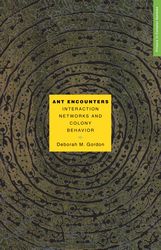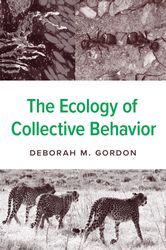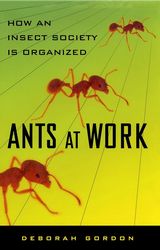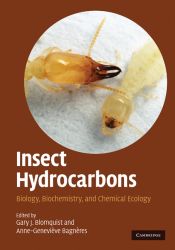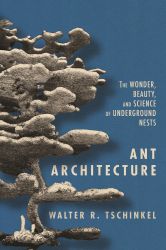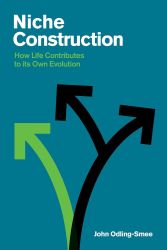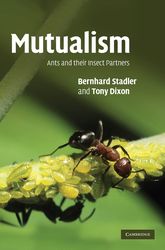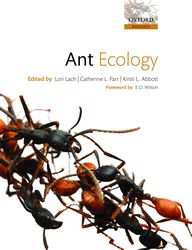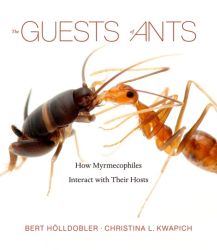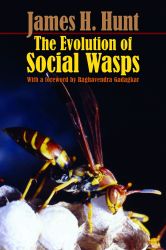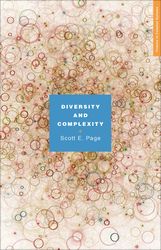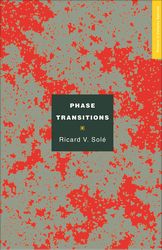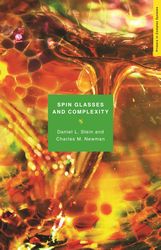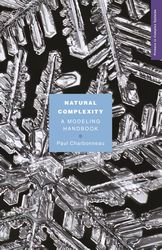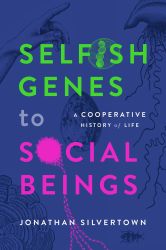keywords: entomology, ethology
This is the second of a trio of reviews in which I take a brief detour into ants and collective behaviour more generally. I previously reviewed The Ant Collective, a graphical introduction to ant behaviour, and am here turning to entomologist Deborah M. Gordon’s 2010 book Ant Encounters before finishing with her recent book The Ecology of Collective Behavior. The core question driving this book is how ant colonies get anything done given that no one is in charge. Her contention, supported by a wide-ranging survey of examples, is that ant colonies function through numerous ants interacting to form a dynamic network. Stated this pithily, I admit it might not sound like much of an answer but rather a rephrasing of the question using fancy words. What do you mean, “interaction network”? If so, read on: this primer is full of fascinating biological examples and interesting insights that will hopefully clarify the above, providing you with a bigger picture of how and why ants behave the way they do.
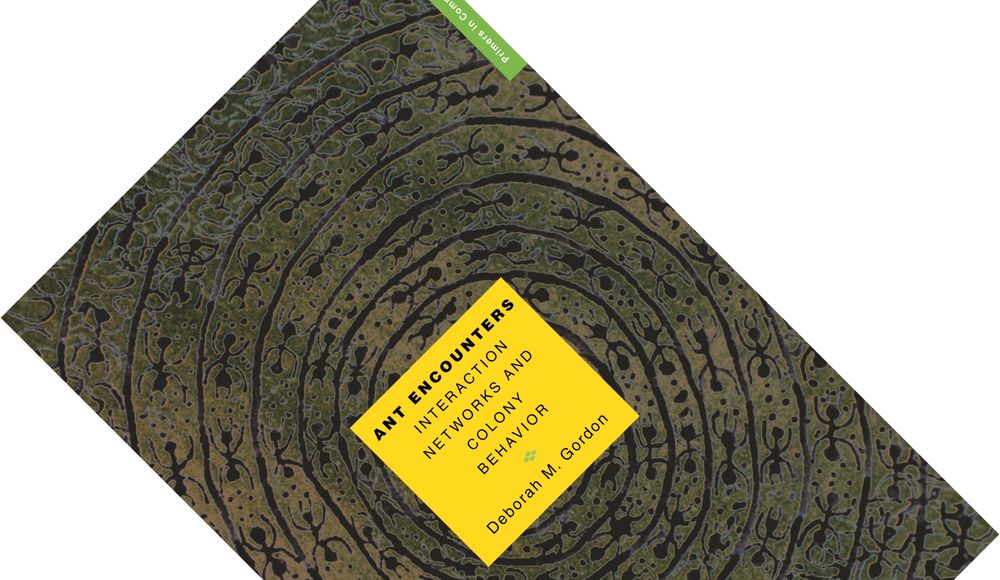
Ant Encounters: Interaction Networks and Colony Behavior, written by Deborah M. Gordon, published by Princeton University Press in April 2010 (paperback, 167 pages)
A brief tangent to get started. Ant Encounters was the first in the then-new series Primers in Complex Systems, produced by the Santa Fe Institute in New Mexico. This is a think tank that studies complex systems in, amongst others, biology, physics, sociology, and computer sciences. Next to a small cadre of resident researchers, they host a rotating cast of visiting academics and provide an environment for cross-disciplinary research, discussion, and exchange of ideas. Some other books I have reviewed here have been the product of, or at least been helped along by, time spent here. Seven books have been published so far in this series, though there have been no new additions since 2019. If this first book sets the tone, these are very interesting and accessible little books that are worth checking out and I have listed them below. Anyway, back to Gordon and ants.
This book follows her popular book Ants at Work published another decade earlier in 1999. At the time of writing Ant Encounters, Gordon had already been studying ants for some three decades, since the early 1980s, mostly the desert-dwelling red harvester ant Pogonomyrmex barbatus. Her work and ideas formed in response to the then-prevailing view that ants are effectively genetically programmed to perform particular tasks. Her early work instead found that what ants do depends on interactions with other ants, which in turn can modify their environment, which in turn can feed back on subsequent interactions, etc. In other words, the behaviour of colonies arises from dynamical, constantly shifting networks of interactions. (The Ant Collective neatly showed in pictures how this works in the waxing and waning of a foraging trail.) After introducing this concept in the first chapter, the remaining six chapters flesh it out with numerous examples at different levels of biological organization.
A logical first question to ask is what ants actually do when they meet. A lot of feeling each other up is what. Communication in ants is firstly tactile, with ants using their antennae to touch each other (entomologists speak of antennation). One of Gordon’s key points is that “the pattern of interaction itself, rather than any signal transferred, acts as the message” (pp. 47–48). Experiments in harvester ants showed that what stimulated foragers to leave the nest was the encounter rate with patrollers returning in the morning. One question for Gordon I was left with was whether smell acts as a message. After all, a second important channel is chemical, with ants, like many other insects, carrying hydrocarbons (so-called cuticular hydrocarbons) on their exterior. These serve as an identity badge but also change during tasks: Gordon’s work on harvester ants showed how ant odour changes as they go outside e.g. to forage. Interestingly, there is individual variation in how active ants are but this is not fixed. Remove particularly active ants and others will take up their workload; there are no “forager heroines” (p. 66).
“A logical first question to ask is what ants actually do when they meet. A lot of feeling each other up is what. […] One of Gordon’s key points is that “the pattern of interaction itself […] acts as the message“”
Scaling up a little to the level of local interactions, Gordon objects to the idea of “division of labour” introduced by famed entomological titan E.O. Wilson. He happened to study some of the few ant species where workers have different body sizes and tried to demonstrate that there was a caste system with size-based task specialisation. Though partially successful, even here individual behaviour changes as needed, with e.g. removal of minors (small ants) causing larger majors to switch to brood care. More importantly, Gordon adds, in most ant species workers are of similar size. Whereas “division of labour” implies static procedures and permanently assigned roles, her preferred term “task allocation” highlights the dynamic, flexible nature of ant behaviour. A related idea that is scrutinized is age polyethism: tasks changing as a function of age. I encountered this in Tschinkel’s book Ant Architecture and though young ants are indeed born in the depths of the nest, the idea that they move up with age and get “promoted” to brood care, nest construction, and finally foraging is more often proposed than backed up with data in the published literature. Experiments on carpenter ants showed that if one age group was removed, others would take over their tasks, suggesting that colony needs override ant age.
Speaking of age, colonies are not static entities and, though there are very few studies on this, colony growth influences behaviour. Particularly important are ant-plant interactions with ants defending host plants from herbivores, thus stimulating plant growth, which in turn begets a larger colony (a nice example of niche construction if ever there was one). In many such mutualisms, there is a third party such as scale insects or aphids that feed by sucking a plant’s sap but are vulnerable to predators. Ants protect them in exchange for the sugary honeydew these sap-suckers excrete from their anuses. The plants tolerate the sap-suckers because the ants thus attracted protect against more harmful herbivores. Ecologist Robert May is quoted as describing such three-way interactions as “an orgy of mutual benefaction” (p. 124).
Scaling up further brings Gordon to the level of inter-colony interactions, both conspecific (between colonies of the same species) and heterospecific (between colonies of different species). Interactions are both direct, e.g. encounter rate with neighbours indicating the size of their colony, and indirect, e.g. competition for food being a zero-sum game: what one colony eats is not available to the other. Bar some spectacular exceptions, fighting between conspecifics is usually avoided. In response to neighbourly interactions, harvester ant patrollers will redirect the next day’s foraging trails. When it comes to heterospecific interactions, conflict has been better studied and Gordon highlights the rise of invasive ant species in the last three decades as another opportunity to do so. In general, numerical advantage trumps body size, with small-bodied species capable of simply swarming larger-bodied ones. A further, delightful level of interaction is between ants and the organisms living in their midst (so-called myrmecophiles) that I discussed at length when reviewing The Guests of Ants.
“In many ant-plant interactions, there is a third party involved, such as scale insects or aphids, in what has been described as “an orgy of mutual benefaction“”
The final level Gordon considers is that of evolution. How did colony organization evolve from ancestors that did not live in colonies? In particular, as workers are unable to reproduce, how did worker sterility evolve? W.D. Hamilton linked it to the haplodiploid mating system of ants where males hatch from unfertilized eggs and carry a single set of chromosomes (haploidy) while females hatch from fertilized eggs and carry the regular two sets of chromosomes (diploidy). One quirk of this system is that, if a queen mates with only a single male, females are more related to their sisters than to their daughters, with kin selection maintaining worker sterility once it somehow arises. The fly in the ointment that Gordon points out is that many queens mate with several males, so Hamilton’s maths quickly unravels, leaving the mystery of worker sterility intact. (In Endless Forms, Sumner explores this story more in-depth, showing there are other reasons why Hamilton’s explanation does not work). What we do know is that ants evolved from vespoid wasps, themselves a case study in the evolution of sociality. Interestingly, worker sterility has evolved many times in wasps and shows more flexibility, with wasps able to become egg layers when needed, arguing against a sudden mutation being responsible for worker sterility in ants. The matter remains unresolved, but Gordon does think that describing social structure in terms of who lays the eggs is “misleading language [that] equates the allocation of egg-laying with social organization and directs attention away from everything else that makes up the diverse and complex social organization of ant colonies” (pp. 130–131).
If all of the above left your head spinning somewhat, then you are not alone. There are some really interesting challenges to established ideas in this slim book, but it took some effort to distil these key points. Much as was the case for The Guests of Ants, this book presents a bewildering variety of examples from many different species, reflecting the state of play in myrmecology. A recurrent theme is that we have extremely limited data. Of the approximately 11,000 ant species known to exist, only 50-odd have been studied in any detail and even then only in fragmentary fashion. “What we have so far are only some of the pieces of many different puzzles; fragments of the picture for army ants, other pieces for harvester ants, others still for fire ants, and so on” (p. 144). Even in this limited sample, exceptions and diversity abound. A brief final chapter considers what it would take to construct models of ant behaviour. This would come to occupy Gordon for the next decade, resulting in the recent publication of The Ecology of Collective Behavior to which I will turn next.
Disclosure: The publisher provided a review copy of this book. The opinion expressed here is my own, however.
Other recommended books mentioned in this review:
__________________________________________________________________
__________________________________________________________________
__________________________________________________________________
__________________________________________________________________
__________________________________________________________________
Princeton’s Primers in Complex Systems:
__________________________________________________________________
Can we predict what aliens will look like? On some level, no, which has given science fiction writers the liberty to let their imagination run wild. On another level, yes, writes zoologist Arik Kershenbaum. But we need to stop focusing on form and start focusing on function. There are universal laws of biology that help us understand why life is the way it is, and they are the subject of this book. If you are concerned that consideration of life’s most fundamental properties will make for a dense read, don’t panic, The Zoologist’s Guide to the Galaxy is a spine-tingling dive into astrobiology that I could not put down.
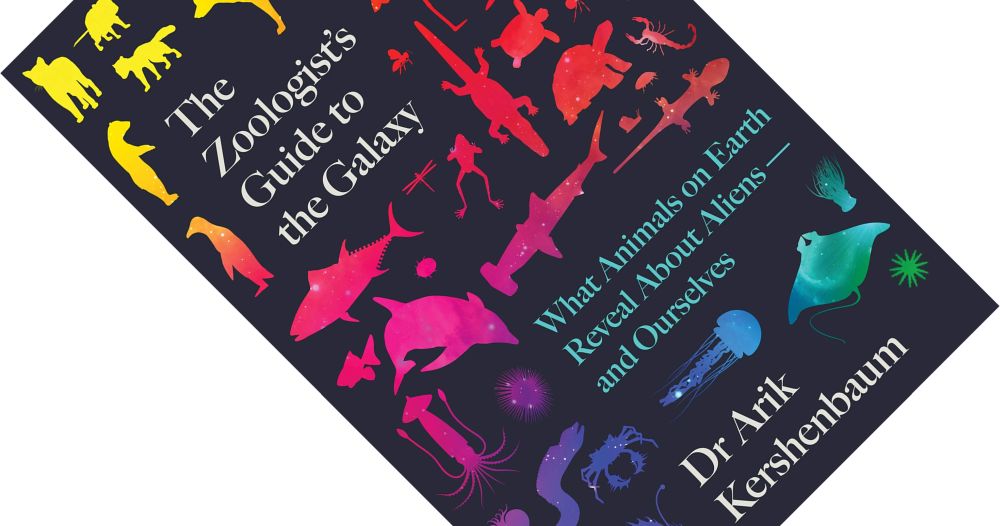
The Zoologist’s Guide to the Galaxy: What Animals on Earth Reveal about Aliens – and Ourselves, written by Arik Kershenbaum, published by Viking in September 2020 (hardback, 356 pages)
Fundamental to answering the question of what alien life might be like, Kershenbaum argues, is to recognize that evolution by natural selection is the most important law in biology, “an inevitable mechanism, not just restricted to planet Earth” (p. 8). Rather than trying to answer particulars (Will aliens have two legs? Six? Or none?), he focuses on process: “Movement, communication, cooperation: these are evolutionary outcomes that are solutions to universal problems” (p. 11). Thus each chapter discusses “some feature of animal behaviour on Earth that is not unique to Earth—that can’t be unique to Earth” (p. 14). These three quotes nail down how Kershenbaum managed to hook me in right from the start of his book.
A key observation to support his argument that natural selection will not be limited to planet Earth is convergent evolution. I find this one of the most exciting topics in evolutionary biology and have written about it extensively last year when reviewing three books in The Vienna Series in Theoretical Biology from MIT Press. Brief refresher should you need it: convergent evolution refers to the ubiquitous pattern of evolution repeatedly hitting on the same or similar solutions to a problem in different organisms. Kershenbaum introduces it here with some examples and also touches on the contingency vs. convergence debate, of which Stephen Jay Gould and Simon Conway Morris are the most prominent spokesmen. Convergent evolution can hold lessons for astrobiology, though George R. McGhee’s book Convergent Evolution on Earth did not quite deliver on its promise to do so. Kershenbaum, however, does. There is no reason to think that convergent evolution would be limited to life on Earth because “we live in a universe where not everything is possible” (p. 46). The laws of physics circumscribe a limited set of possibilities, something that Charles Cockell so memorably expressed by writing that “physics is life’s silent commander“.
So what are these characteristics that we can expect to evolve universally? Kershenbaum considers six, from very basic to likely rarer: movement, communication, intelligence, cooperation, information exchange, and language. Even though these are very fundamental properties of life that you could talk about in abstract terms, what makes The Zoologist’s Guide to the Galaxy so accessible is Kershenbaum’s pithy writing style. I will highlight three examples to give you a taster.
“[Kershenbaum] focuses on process: “Movement, communication, cooperation: these are evolutionary outcomes that are solutions to universal problems“”
Take movement: “We move because we must, not because we can […] Life needs energy, and if energy is not evenly distributed, life must go in search of it” (p. 70–72). Earth life has tried pretty much every mechanism we can think of to move in a fluid medium (air or water) or on the interface between a fluid and a solid, so expect alien life forms to float, paddle, or develop legs.
Cooperation similarly seems likely. There is a range of benefits to individuals cooperating, not in the least the threat of predation. “Predation is universal, because no ecosystem can exist for long without someone trying to take a bite out of somebody else; the selective pressure on acquiring as much energy as possible is just too strong” (p. 171). When and whether it is evolutionarily advantageous to evolve cooperation is something we can answer mathematically using game theory, “a simple technique, applicable on any planet” (p. 192). We should not be surprised to find aliens with complex social structures, dominance hierarchies, and reciprocal behaviour.
A full-blown language, on the other hand, seems uniquely human. This chapter leads you through the difficulty in defining language and grammar, the contentious topic of language evolution, and an interesting dive into xenolinguistics, or how you would recognize whether a signal carries the signature of language. These are all areas of active research where no consensus has been reached between different schools of thought. Nevertheless, Kershenbaum identifies two fundamental features that an alien language would have: it is a means to communicate complex concepts, and it evolved by natural selection.
“There is no reason to think that convergent evolution would be limited to life on Earth because “we live in a universe where not everything is possible“. The laws of physics circumscribe a limited set of possibilities […]”
This core of six chapters is padded out with a fascinating chapter that considers artificial life forms. After all, evolution as we know it acts blindly, without foresight. “But what if it were all different? What would life look like if it did know where it was going?” (p. 258). Well, perhaps not all that different. “Game theory […] is ruthlessly inevitable” (p. 280), so expect conflict and cooperation. Furthermore “some things like mutation, and even death, can’t be eliminated just by being incredibly smart” (p. 286).
The whole is bookended by two more philosophical chapters. The first asks what an animal is and whether aliens would be considered animals. Though we would not share ancestry, the point of this book is to show that we would likely share fundamental processes and properties. The last chapter considers the impact that the discovery of alien life would have on us and whether we would recognize such life forms as a fellow form of humanity. Throughout, there are footnotes to general literature, and an annotated list of suggested reading provides plenty of material if you want to delve deeper.
Kershenbaum admits that you probably wanted him to tell you what aliens look like, and his book contains less speculative zoology than e.g. Imagined Life. However, by the same logic of giving a man a fish vs. teaching him how to fish, understanding the rules that life follows is ultimately more rewarding. Kershenbaum’s smooth writing style makes it a proper page-turner.
Disclosure: The publisher provided a review copy of this book. The opinion expressed here is my own, however.

Other recommended books mentioned in this review:
__________________________________________________________________
__________________________________________________________________
__________________________________________________________________
]]>Saying that the COVID-19 pandemic should not have happened will likely elicit one of two responses. Blaming China for initially trying to cover it up, or saying: “shit happens, this is speaking with the benefit of hindsight”. Appealing as these may sound, they are missing the bigger picture. The awful truth is that we have had this one coming for a long time.

COVID-19: The Pandemic that Never Should Have Happened, and How to Stop the Next One, written by Debora MacKenzie, published in Europe by The Bridge Street Press (a Little, Brown Book Group imprint) in July 2020 (hardback, 279 pages)
Seeing this is a very hot topic, I think it is worth pointing out what you will not find in this book before diving into the rest of the review. Despite the title, you will not find all that much about the virological, epidemiological, or clinical details of COVID-19 and the virus SARS-CoV-2. As we are still in the middle of learning the biological details, you are better off just keeping a close watch on the news. That post-mortem will have to wait—although the primer Understanding Coronavirus provides useful basics on what we know so far.
The clue is in the subtitle. Debora MacKenzie writes this book from her unique vantage point as a veteran journalist reporting on infectious diseases for New Scientist and other outlets for over 30 years. With the world’s attention on pandemics, now is the best moment to draw our collective attention to her shocking tale of neglect and complacency in the face of warnings from the scientific community. This was true when Quammen wrote Spillover, and it still holds today.
“The clue is in the [book’s] subtitle […] now is the best moment to draw our collective attention to [a] shocking tale of neglect and complacency in the face of warnings from the scientific community.”
Judging by what MacKenzie describes here, it has been a perfect storm of various factors that got us to this point. There was a surge of optimism in the 1970s: we eradicated smallpox, we had vaccines to prevent childhood diseases, and antibiotics stopped all sorts of harmful bacteria. A leading medical textbook at the time even declared the future of infectious diseases to likely be very dull. Research departments were downsized as funding dried up. Public health stopped being a state-funded public good as the medical industry was swept up in the wave of privatisation of the 1980s. And networks for research and disease monitoring in developing countries were cast off as excess baggage from colonial times. In short, high on its medical triumphs, the world grew complacent.
But our victory was short-lived.
Ever since AIDS went global in the 1980s, disease experts have been trying to predict what might be the next big threat. We all know of the rise of antibiotic-resistant bacteria, but we also have had plenty of viral near-misses, such as Ebola, Zika, SARS, and MERS. Seeing the relevance of the latter two—they are both caused by coronaviruses—MacKenzie covers their outbreaks in detail. And then there is a whole chapter on flu, the annual recurrence of which has become so routine that we have stopped calling it a pandemic. Next to straightening out the misconception that COVID-19 “is just another kind of flu”, this is relevant because what little governments have in the way of pandemic preparedness plans is based around flu outbreaks. And those prominently do not recommend containment measures: pointless for the fast-moving flu, but relevant for COVID-19.
“[…] MacKenzie asks: what about traditional Chinese medicine? Both horseshoe bats, which carry coronaviruses, and their faeces are ground up wholesale and used to, for example, treat eye infections.”
This is the background against which warnings have been issued and, by and large, ignored. The World Health Organisation (WHO) has had a list of the viral Most Unwanted for years, prominently mentioning coronaviruses. Disease experts, reporters (MacKenzie amongst them), and writers of popular books have sounded the alarm for years. But hey, we have had enough of experts, right? If that was not enough of a slap in the face of science deniers, she ruthlessly despatches some harmful conspiracy theories (no, this virus was not brewed up in a laboratory).
Before getting to proposed solutions, MacKenzie dives down a few rather relevant rabbit holes. One is a very interesting chapter on bats. Bats host numerous viruses that can jump to humans, so they warrant close monitoring. MacKenzie issues a plea to not shoot the chiropteran messenger: certain groups are important pollinators. Plus, and this will not go down well with some but is something I appreciated, human overpopulation and the accompanying encroachment into wild habitats are the root causes here. She dispels as a red herring the idea of pangolins as an intermediate host. But most interesting of all, she casts a shadow of doubt on the whole bushmeat and wet market story. Yes, bats are eaten in parts of the world, but they are usually larger fruit bats. Instead, MacKenzie asks, what about traditional Chinese medicine? Both horseshoe bats, which carry coronaviruses, and their faeces are ground up wholesale and used to, for example, treat eye infections. Next to that potential infection pathway, it involves catching and handling bats. So far this is speculation, but these are reasonable questions to ask. One of the things I really appreciated in this book is that MacKenzie does not mince her words and is not afraid to broach contentious topics.
The other seeming rabbit hole is that of the complexity of our societies. What if a more lethal pandemic emerges? This is a short trip into the science of complex systems, feedback loops, tipping points, resilience to shocks, global supply chains, and, ultimately, the possibility of rapid collapse. Oh, and, depending on your point of view, a (un)surprising list of typically undervalued and poorly paid jobs that actually keep society running.
“the most important lesson […] is recognizing that profit-driven market forces cannot deliver new vaccines and antibiotics. “
These two topics return in the extended list of seven lessons for the future with which MacKenzie sees the book out. Most of these involve changes at the international level. What we do not need now is blame games. What we do need is more openness and cooperation regarding disease surveillance. Despite some criticism of the WHO here, she also highlights just how limited their budget is, and how their hands are tied due to the sovereign rights of nation-states that can simply hide information and refuse health inspections. We need more preparation, both in the form of research and stockpiling of supplies. We need to recognize systems complexity and accept reduced efficiency (and thus increased costs) to allow more redundancy and resilience in global supply chains. But the most important lesson, I thought, is recognizing that profit-driven market forces cannot deliver new vaccines and antibiotics. This is not about “evil corporations”, it is simply that the risk of failure and the frequent lack of return on investment work against us. This is why we have governments that fund public goods.
MacKenzie admits that COVID-19, written as it was in a mere two frenetic months, is somewhat rough around the edges. Personally, I think illustrations would have helped to explain certain biological details that she presumes understood, and an index would have been useful. But given the circumstances, their omission is perfectly understandable. What the book does deliver is a perfectly-timed, intriguing, and revelatory story of the dangers of ignoring science. And for a debut book, this is all the more impressive.
In closing, you might wonder how this book compares to The COVID-19 Catastrophe by the editor of The Lancet Richard Horton, the subtitle of which is very similar to this book. That book is shorter, focuses exclusively on the science policy failures, and leaves out a lot of the background provided here and elsewhere. It does, however, provide an insider’s perspective of someone who worked for the WHO.
Disclosure: The publisher provided a review copy of this book. The opinion expressed here is my own, however.
Other recommended books mentioned in this review:
__________________________________________________________________
__________________________________________________________________
__________________________________________________________________
]]>Collapse is a feature, not a bug. This motto is almost like a mantra to physical chemist Ugo Bardi. He is interested in complex systems and how they collapse. Whether they be human-made structures, companies, societies, or ecosystems; he follows the thinking of Roman philosopher Lucius Annaeus Seneca (4BCE–65CE) who wrote, in Bardi’s words, that “growth is slow, but the way to ruin is rapid”. This led Bardi to write The Seneca Effect in 2017, which was reviewed here previously. Now he is back with Before the Collapse, a book aimed at a wider audience that promises to help readers understand and navigate collapses in their lives.

Before the Collapse: A Guide to the Other Side of Growth, written by Ugo Bardi, published by Springer in October 2019 (paperback, 242 pages)
Bardi opens his book with a chapter on modelling. Before we even get to describing the growth and collapse of complex systems, he wants readers to understand how we do this describing. The thing about complex systems is that they are… well, complex. Whether it is the weather forecast or the depletion of fossil fuel reserves, scientists often turn to models, and this approach is often eyed suspiciously or even belittled by the general public. Something that he thinks is entirely unjustified.
So, before proceeding, Bardi wants readers to understand the difference between top-down and bottom-up approaches to building a model, and their advantages and limitations. He is especially interested in the failure of models to predict rapid, unexpected changes (so-called tipping points, though Bardi calls the catastrophic variants Seneca cliffs), and their inability to foresee statistical outliers: the unpredictable, potentially devastating, never-before-experienced events that have been popularised as black swans. He also highlights the psychological biases that lead us to disbelief models, whether through emotions, biases, gullibility, inappropriate rules of thumb, or a false sense of security that makes us overestimate the chances that model predictions will be wrong.
“[Bardi] is especially interested in the failure of models to predict tipping points, and their inability to foresee statistical outliers: the unpredictable, potentially devastating, never-before-experienced events popularised as black swans”
With the value of models sufficiently established, Bardi moves on to describe the anatomy of complex systems and the various growth modes by which they can develop. But the bulk of the book is a catalogue of catastrophes. As in The Seneca Effect, this includes human-engineered structures, financial and societal collapses, resource depletion, famines, and ecosystem collapse, but also some new categories such as natural disasters, warfare, epidemics, and depopulation. Some examples were already covered in his last book, including the peak oil concept and the Irish famine of 1845. Others, though, are new, such as the 2018 collapse of the Morandi bridge in Genoa, the bankruptcy of video rental company Blockbuster, the great 1966 flood of Florence that Bardi experienced personally, and some of history’s most fatal wars. Bardi writes of them with his typical sense of often grim and ironic humour, and a bold, fearless attitude that sees him confront uncomfortable facts of life with almost Stoic calm.
The book’s preface promises that this is a completely new and different book, though I feel he only partially delivers on that promise. If you have not read The Seneca Effect this, of course, is not much of an issue. The blurb mentions that “this book will help you […] face failure and collapse at all scales […] and navigate the swirl of events that frequently threaten your balance and happiness“, and the preface expresses the hope that “you will find this book useful for your life and your career“. Based on this I was expecting if not a kind of self-help book, at least something in the way of applied lessons on a personal level. But it seems that once Bardi gets to his chapter on strategies to manage collapses, he has abandoned this plan and partially retreads his last book, though, admittedly, with some new examples.
“Given that we have depleted easily accessible fossil fuel and mineral resources during the past few centuries, could we reboot civilization after a crash?”
So, the option of technological progress against collapse is new. Here, Bardi focuses on new ways to meet our energy needs, covering the pipe dream of cold fusion research, futuristic concepts such as universal mining machines, and our likely saviour, renewable energy. The section on avoiding overexploitation is confusingly more a showcase of how not to avoid collapse, highlighting how politics and greed often come together to deplete the resources we depend on.
Not new is the section on the Iago strategy, previously covered as hostile collapses – this is the dark side of the Seneca cliff, the use of deception and betrayal to avoid ruin by destroying an opponent in, for example, warfare. Also not new is the discussion on different forms of governing resources, the tragedy of the commons, the question of whether democracy and privatisation can stave off collapse, or the example of Japan during the Edo period as a rare case of a zero-growth society with exceptional long-term stability.
“[…] unless you are in a position of power, you have little influence to change or avert collapses. For most people, the best strategy is to familiarise yourself with the concept of collapses so that you may both understand and recognize them”
And The Seneca Effect also already explored the possibility of rebound after collapse, though Bardi here asks the interesting question if this would be possible after the collapse of our current society. Given that we have depleted easily accessible fossil fuel and mineral resources during the past few centuries, could we reboot civilization after a crash? Keep in mind that geochemical processes will not replenish these reserves in our lifetimes, if ever. Still, he thinks recycling mineral resources to kick-start a renewable-energy–based infrastructure could be an option. I would add that we might also want to have at hand ample copies of Lewis Dartnell’s The Knowledge.
If I have to be critical, I have two gripes with this book. One is that I feel the book wanders a bit. I personally very much enjoy the subject matter and am happy to accompany Bardi as he muses his way through the book. But I do think it would have benefited from both proofreading to catch out grammatical errors, and especially from some critical editorial attention. A revision of the text might have resulted in something more coherent and novel that truly sets itself apart from his previous book, something it now only partially succeeds in doing.
Second, as mentioned above, based on the blurb and the preface I expected a slightly different book with more actionable advice (a six-point summary at the end of the book contains a few pointers). However, given the nature of complex systems it appears that, unless you are in a position of power, you have little influence to change or avert collapses. For most people, the best strategy is to familiarise yourself with the concept of collapses so that you may both understand them and recognize when they are imminent or already underway. And that is something this book does succeed in. I am convinced that readers will come away with plenty of ideas to mull over.
Disclosure: The publisher provided a review copy of this book. The opinion expressed here is my own, however.

or ebook
Other recommended books mentioned in this review:
__________________________________________________________________
]]>There is an amusing and slightly acerbic acronym that has stuck with me from my days working at a computer helpdesk for an international oil firm: PICNIC. Short for “problem in chair, not in computer”, my colleagues used it as code whenever an employee rocked up at our helpdesk with a complaint or problem that was due to human clumsiness rather than malfunctioning hardware. “Did you check that the printer was plugged into the power socket?”
Nevertheless, says Artificial Intelligence (AI) researcher Robert Elliott Smith, our blind faith in computers and the algorithms that run them is misguided. Based on his 30 years experience working with AI, the aptly titled Rage Inside the Machine takes the reader on a historical tour of computing to show how today’s technology is both less amoral and more prejudiced than we give it credit for.
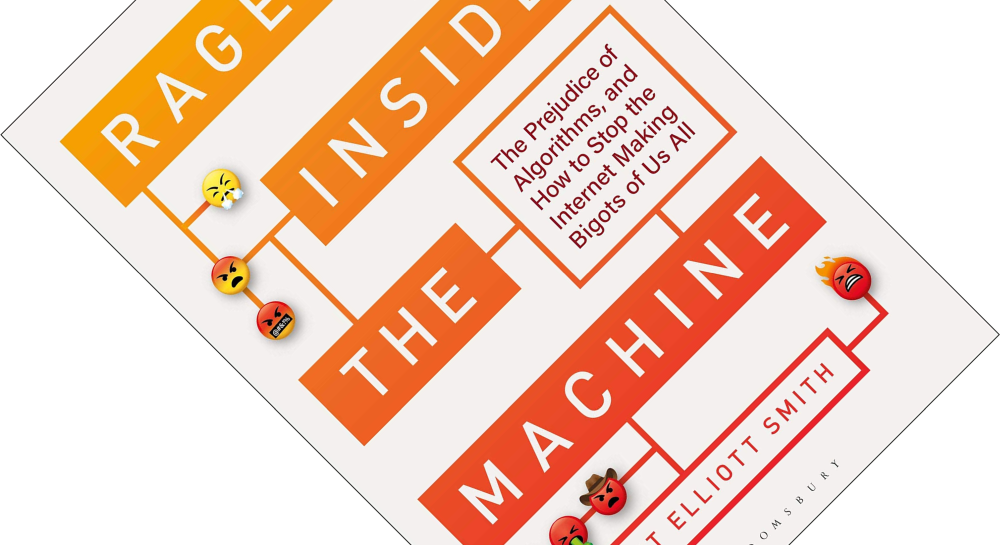
Rage Inside the Machine: The Prejudice of Algorithms, and How to Stop the Internet Making Bigots of Us All, written by Robert Elliott Smith, published by Bloomsbury Business (a Bloomsbury Publishing imprint) in June 2019 (hardback, 344 pages)
At their silicon hearts, computers are just big number crunchers. This has led to the tacit assumption that computers are rational machines that cannot possibly be biased, as opposed to humans. But this, says Smith, is a mistake. The theories and findings that gave rise to today’s algorithms go back several centuries and are products of their times, and this historical context is often ignored in contemporary discussions. A large part of Rage Inside the Machine, therefore, is a trip down memory lane.
The first historical vignette goes back all the way to 1290 when Christian scholar Ramon Llull tried to make a mechanical device that would give irrefutable proof that Christianity was the one true faith. Goofy as this may now sound, it did lead him to write about the mathematical subdiscipline of combinatorics, which in turn influenced scholars and philosophers centuries down the line. Combinatorics is quite simply the study of how many possible combinations you can make with a given number of component parts. What it reveals about reality is that extremely complex problems – ones that are easy to describe but hard to solve – are actually surprisingly common. The travelling salesman problem is probably the most well-known example of a problem where the number of possible solutions rapidly balloons. Thus, to provide us with answers, algorithms simplify real-world processes and are by their very nature reductionist.
With that firmly in mind, Smith proceeds to look at the historical antecedents of various facets underpinning AI, with the occasional foray into equations and Venn diagrams. He thus discusses the history behind probability theory, which is the mathematical modelling that uses statistics to analyse complex data. And he shows how Darwin’s theory of evolution by natural selection was rapidly appropriated and applied to social contexts. When combined with Friedrich Gauss’s concept of the bell curve (a graph that shows the dispersion of data either side of an average value), it was used as justification for eugenic practices aimed at the betterment of the human race by eliminating statistical outliers.
“[…] to provide us with answers, algorithms simplify real-world processes and are by their very nature reductionist.”
One of the most notorious tools that came out of this form of social Darwinism, which is still with us today, is the intelligence quotient (IQ) test. It has been used to prop up racism and sexism for decades. Less well-known is that other statistical tools had equally less salubrious origins, with links to both eugenics and mental asylums (the name Karl Pearson might ring a bell from your statistics classes).
The current fears that AI will soon make large swathes of humanity unemployable (also see CGP Grey’s excellent video Humans Need Not Apply) is an echo of what happened when the Industrial Revolution replaced the cottage industry with factories. Conversely, the notion that you can increase efficiency by dividing labour influenced how humans did complex computations before technology could help out – it led to groups of skilled people in computing factories breaking down the task into bite-sized chunks.
“The current fears that AI will soon make large swathes of humanity unemployable […] is an echo of what happened when the Industrial Revolution replaced the cottage industry with factories”
Other important figures that feature in Smith’s story are Alan Turing, Claude Shannon, and Noam Chomsky. Turing, and the test named after him, gave rise to the idea that the brain is just a computer. Shannon’s information theory underlies all electronic communication today. And Chomsky studied human language, particularly its syntax, and his contributions are still relevant to the current struggle of algorithms to really understand human language with all its subtleties. Ironically, much discussion on AI is muddled by the language we use to describe what algorithms are doing, resulting in wishful mnemonics: the naming of computational phenomena with words denoting human characteristics and capabilities. “Does Google’s AlphaGo programme really intuitively decide on its next move when playing Go?”, asks Smith.
Throughout his book, Smith links the historical material back to current concerns around AI. One of the take-away messages that he repeatedly hammers home is that the assumptions and simplifications we have built into our algorithms are wedded to historical prejudices and baggage. And by their very nature as relentless optimisers, algorithms will reinforce these and feed them back to us, as examples of racist and misogynist AI bloopers show.
Still, as the book progresses, I increasingly felt Smith went a bit off-script. I think the book’s subtitle initially put me on a wrong footing and led to me expecting more social commentary and less history. There were certain points in the book where I wondered “what does this have to do with current concerns about social networks?” One example is when he writes of his work for aerospace company McDonnell Douglas. Here he trained genetic algorithms, which mimic evolution to find better solutions, to learn the fighter jet maneuvres of top-gun pilots. Though, to his credit, those same genetic algorithms can help us understand how social network architecture leads to the self-reinforcing filter bubbles that have become a grave concern (but see the critique Are Filter Bubbles Real?).
“While Silicon Valley is awash in dreams of the coming Singularity […] Smith sees a far more immediate problem in the unholy trinity of scientism, computation, and commercialism.”
Together with books such as The AI Delusion and Rebooting AI, Smith clearly falls in Camp Cautious. While Silicon Valley is awash in dreams of the coming Singularity, when AI will eclipse human intelligence, Smith argues that beyond computers having become more numerous, powerful, and connected, not much has changed. I would add that the maxim “garbage in, garbage out” still stands firmly. Rather than the future existential threat of AI that some fear, Smith sees a far more immediate problem in what he calls the unholy trinity of scientism, computation, and commercialism. We obliviously trust the powerful algorithms employed by large firms such as Facebook that have penetrated every nook and cranny of our everyday lives. And it is easy to forget they have but one objective: maximize profit. And that, argues Smith, is far more dangerous to humankind than nightmarish visions of the robot apocalypse.
So, how can we stop the internet making bigots of us all? Smith is not outspokenly prescriptive, though his work on evolutionary algorithms suggests we can create a different kind of beast, a breed of diversity-preserving algorithms rather than the relentless optimizers underlying current online social networks. Instead, the goal of this book is foremost to educate readers, to arm them with a better understanding of how algorithms work by simplifying reality, and to raise awareness of how their inner workings betray the past prejudices that are still baked into them. To that end, Smith presents a very pleasant and accessible mix of revealing history, personal anecdotes, and sharp observations.
Disclosure: The publisher provided a review copy of this book. The opinion expressed here is my own, however.

or ebook
Other recommended books mentioned in this review:
__________________________________________________________________
__________________________________________________________________
__________________________________________________________________
]]>
“Biology’s First Law: The Tendency for Diversity & Complexity to Increase in Evolutionary Systems“, written by Daniel W. McShea and Robert N. Brandon, published by the University of Chicago Press in August 2010 (paperback, 170 pages)
The authors dive right in with some definitions, and to discuss this book it will be helpful to repeat these. If you have an evolutionary system, and you assume variation and heredity, then diversity and complexity will on average increase, unless other forces, e.g. natural selection, constrain or override this tendency. The authors give two definitions and point out they do not consider the ZFEL a new discovery. Rather it is a recognition of, and unifying principle for a range of findings across biological disciplines. When not subject to selection, differences tend to accumulate, both within organisms (e.g. random mutations or gene duplications leading to pseudogenes) and between them (the increasing diversity and complexity of life over evolutionary history).
McShea and Brandon quickly move to clarify what they mean with diversity and complexity. Especially the latter has a colloquial usage indicating sophistication, functionality, etc. They are not interested in this and define “pure” complexity: the number of part types making up a structure, or the degree of differentiation between parts – nothing more. And this creates a hierarchical relationship between the two: diversity at one level makes for complexity the next level up. For example, a great diversity of cells makes for a complex organism.
An important and very interesting consequence of their line of thinking is that it invites a so-called gestalt shift: a change in what is considered background and what foreground. In their view, change is the constant, with natural selection acting more to reign in the creative maelstrom generated by the ZFEL. In their final chapter, they consider how this provides a satisfying answer to the challenge often raised by creationists: how do complex structures such as eyes arise? Biologists often respond by suggesting a series of intermediate steps, each a little bit better than the last one, each selected for, which risks descending into just-so stories. But if the ZFEL creates diversity and complexity in abundance, natural selection acts more by whittling down and constraining that which is useful, meaning intermediate steps are not strictly necessary (which is not to say they do not occur, see e.g. Evolution’s Witness: How Eyes Evolved).
“The ZFEL […] provides a satisfying answer to the challenge often raised by creationists: how do complex structures such as eyes arise?”
Biology’s First Law is a brief book and throws out an interesting if provocative idea. Although the topic is rather technical and abstract, the authors do a great job keeping the reader on board, repeating important caveats where necessary, and being explicit in what they mean. Even so, some of the examples and argumentation feel, well, a bit clunky.
My first thought a few pages in was: “isn’t this just entropy?” The second law of thermodynamics states that there is a natural tendency for systems to become increasingly disordered and chaotic with time, while maintaining order takes a constant input of energy and effort. This is why stuff breaks and falls apart. The authors are adamant that it is not, and, to their credit, marshall convincing arguments (though see Cosmic Evolution: The Rise of Complexity in Nature for an example that does use entropy as an explanation). What does not help their argument, though, is that the two analogies they repeatedly use in the book (a picket fence breaking down and the wind scattering leaves in a garden) are prime examples of entropy in action.
Second, in some places the writing starts to reek of ad-hoc explanations and special pleading. They suggest that if complexity and diversity do not increase, you just need to invoke a mechanism (genetic drift, an absorbing barrier, stabilising selection) to explain why not. And any such inhibiting mechanism would not challenge the ZFEL, say the authors. Take it away and the tendency for the ZFEL to increase diversity and complexity will resume. Basically, they take the ZFEL to always be true, which does not leave much room for falsification.
“Taking the ZFEL to be true is putting the cart in front of the horse – possibly a purposeful provocation to get people thinking. For now, it is a hypothesis. “
Third, given the starting points of several of their hypothetical examples, the outcomes are self-evident: a picket fence with identical pickets, a population of initially identical organisms, a wormlike animal with identical segments. These systems are at the extreme end of morphospace (the space of possible configurations) and can only develop in one direction. What about real-life systems, in all their messy glory? Wagner’s computational work and identification of astronomically large spaces of possibility are interesting in this context (see Arrival of the Fittest: Solving Evolution’s Greatest Puzzle).
Tying in with that, despite the author’s purported humility, calling their idea a law and drawing parallels to Newton’s first law is anything but. Taking the ZFEL to be true is putting the cart in front of the horse – possibly a purposeful provocation to get people thinking. For now, it is a hypothesis. To their credit, they outline what research needs to be done to falsify their idea and they provide some interesting evidence. Some of this is not supportive and they evade this by the epistemological escape hatch I mentioned above: just find an ad-hoc constraint to invoke.
Usually I review new books, but since this is a 2010 book we can ask: what has become of this idea? I have not done an exhaustive search, but there are two noteworthy follow-up papers I immediately found. Puzzles for ZFEL, McShea and Brandon’s Zero Force Evolutionary Law was published in 2012 in Biology & Philosophy (PDF here) and raises several points of criticism, different from mine and more thoroughly developed. A Quantitative Formulation of Biology’s First Law was published only last month in Evolution (PDF here) and is a modelling exercise for discrete and continuous traits.
Biology’s First Law is a very interesting, thought-provoking book and I think the authors are on to something, but this idea needs developing. Some of the examples and arguments here are self-evident or not very strong. And I’m not yet convinced that we need a name for this, calling it “stochastic processes” or “randomness” fits the bill just fine in my view.
Disclosure: The publisher provided a review copy of this book. The opinion expressed here is my own, however.

, hardback or ebook
Other recommended books mentioned in this review:
]]>
“Quarks to Culture: How We Came to Be“, written by Tyler Volk, published by Columbia University Press in May 2017 (hardback, 250 pages)
Biologists are fascinated with these questions, and plenty of books have marvelled at the vast chain of being, trying to discern patterns. This ranges from popular treatments such as Life Ascending: The Ten Great Inventions of Evolution or Restless Creatures: The Story of Life in Ten Movements to more scholarly ones, such as The Major Transitions in Evolution, The Major Transitions in Evolution Revisited, or Biology’s First Law: The Tendency for Diversity & Complexity to Increase in Evolutionary Systems. Some say it is energy, others that it is information. “No, physics is life’s silent commander”, says a third (see respectively The Vital Question: Why is Life the Way it is?, and my reviews of The Demon in the Machine: How Hidden Webs of Information Are Finally Solving the Mystery of Life and The Equations of Life: The Hidden Rules Shaping Evolution). But Volk wants to look beyond this, at, as he puts it, “the whole shebang”, all the way from elementary particles to political states, from quarks to culture, to search for a universal pattern. And Volk sees one.
See, Volk says, our world, our whole universe, is like a giant Matryoshka doll, one set of things nested inside the next. (Actually, he does not refer to these Russian dolls anywhere, I do – but it’s a fitting metaphor.) Simple things combine to form larger complex wholes that have new properties. This is the phenomenon of emergence (see e.g. Emergence: The Connected Lives of Ants, Brains, Cities And Software) and is the domain of systems theory and complexity studies. And that is the universal pattern that Volk sees.
But he is not content with calling it emergence, instead calling it “combogenesis”: things combine and integrate with other things into new, larger things at a new level. At this new level, these larger things can form new kinds of relationships with others at the same level, giving rise to yet another new level. And so on, in an upwards cascade of nestedness, something he dubs the “grand sequence”. Now, throwing around your own terms and calling things “grand sequences” all sounds a bit, well, grandiose and reeks of hubris. Luckily, that is not at all the spirit of this book, and Volk keeps things uncomplicated and pragmatic, talking of “things” and “levels”.
“[…] our world, our whole universe, is like a giant Matryoshka doll, one set of things nested inside the next.”
In twelve chapters, Volk takes that logic to reason his way up twelve levels. So, fundamental quanta (quarks, leptons, bosons, etc.) combine to form nucleons (protons and neutrons), which combine to form atomic nuclei, and on it goes to atoms, molecules, prokaryotic cells, eukaryotic cells (here Volk invokes endosymbiosis, see One Plus One Equals One: Symbiosis and the Evolution of Complex Life), multicellular organisms, animal social groups, human tribes, agricultural settlements, and finally geopolitical states.
A final series of chapters looks at the whole sweep, highlighting several interesting observations. First off, as he acknowledges, it is unapologetically anthropocentric. I am sure that following the same reasoning you could draw up other “grand sequences” with different endpoints (molecules, stars & planets, galaxies, superclusters?). But Volk wants to focus on how we humans got to where we are. Second, are there more levels further down or higher up? The latter is something he speculates on in the epilogue. The former, as he points out, is what physicists are labouring over worldwide, with string theory being one, albeit controversial candidate (see e.g. The Elegant Universe: Superstrings, Hidden Dimensions and the Quest for the Ultimate Theory versus Not Even Wrong: The Failure of String Theory and the Continuing Challenge to Unify the Laws of Physics).
It also spans several fields, from physics to biological evolution to cultural evolution. Volk introduces the idea of dynamical realms, with certain steps (such as from molecules to cells) heralding a major transition, literally opening up a new world of possibilities. Cells, then, are the base level of the realm of biological evolution. Is there an explanation for these major transitions? Here he names one last new concept: the alphakit. An alphakit contains a small number of elements that can be combined into an enormous number of possible ways. The first example to come to mind is how a limited number of letters (or really phonemes: distinct units of sound) can be combined into almost unlimited arrays of words, sentences, books, etc. You can do a lot with those basic building blocks.
“Volk introduces the idea of dynamical realms, with certain steps (such as from molecules to cells) heralding a major transition, literally opening up a new world of possibilities. “
The argument is not so neat that an alphakit automatically signals a major transition. For example, there are only 92 stable kinds of atoms, but the number of possible molecules is huge. However, molecules are not, by themselves, alive. At this point we’re still in the realm of physics. Indeed, how inanimate matter becomes alive remains a vexing question, see e.g. What is Life? How Chemistry Becomes Biology. But the reverse seems to hold: major transitions seem to require these alphakits. On the border of the realms of physics and biology few atoms give rise to many molecules. Some of these molecules (the combo of four DNA bases and a small number of amino acids) give rise to larger numbers of other molecules (genes and proteins). Same at the transition from biological evolution to cultural evolution where a small number of phonemes gives rise to language, allowing for the next series of iterations. Also invoked here is the concept of a field of possibilities, which are all the theoretically possible combinations of elements. Wagner introduced this in his fascinating Arrival of the Fittest: Solving Evolution’s Greatest Puzzle to argue how evolution can probe these multidimensional spaces of possible protein sequences to rapidly come up with innovative solutions to life’s problems.
Earlier on, Volk makes a distinction between what is and is not a case of combogenesis. So, cells combining to form multicellular animals is combogenesis, but whales evolving from worms is not. The latter is a matter of “more of the same”, not “more of a different kind”. By that logic, the alphakits Volk introduces sometimes involve combogenesis (from atoms to molecules), but sometimes they don’t (from amino acids to proteins, these are both types of molecules).
No doubt readers both inside and outside of complexity studies will find plenty to question and criticise here. I mentioned the possibility of other “grand sequences”. Harold Morowitz did a similar exercise in his book The Emergence of Everything: How the World Became Complex, but required 28 steps. And I wonder: is combogenesis really different enough from emergence to warrant its own term?
My impression is that Volk would be delighted to see his ideas discussed. Quarks to Culture is engagingly written, often chatty (a style I personally enjoy). To wade into subatomic particle physics as a biologist is courageous of Volk, but he seems to have read up on the topic and spoken to plenty of colleagues who explained it to him. Volk excels at translating that for his readers, kindling a new interest in me. Despite the questions and eyebrows this book might raise for some, if you read it in the spirit it was intended – a thought experiment rather than a fully-fledged theory – I expect you will find it a rewarding and thought-provoking intellectual exercise.
Disclosure: The publisher provided a review copy of this book. The opinion expressed here is my own, however.

or ebook
Other recommended books mentioned in this review:
__________________________________________________________________
__________________________________________________________________
__________________________________________________________________
__________________________________________________________________
]]>Sorry, that’s a trick question, for the answer to this is anything but quick. The mind-boggling complexity that is life, even something as “simple” as a bacterium, somehow arises from atoms and molecules. And yet, physics and chemistry as we currently know it seem incapable of answering how life’s complexity emerges from its constituent parts. With The Demon in the Machine, well-known physicist and cosmologist Paul Davies takes a stab at it, saying we are on the verge of a breakthrough.

“The Demon in the Machine: How Hidden Webs of Information Are Finally Solving the Mystery of Life“, written by Paul Davies, published by Allen Lane in January 2019 (hardback, 251 pages)
Davies is not the first to ask this seemingly simple question. He takes as his starting point the 1944 book What is Life? by the famous physicist Erwin Schrödinger. Schrödinger and others noted that the very existence of life seems to violate one of the fundamental laws of physics: the second law of thermodynamics, i.e. the universal tendency towards disorder, or, more formally, an increase in entropy. But life does the opposite, creating order and complex, organised structures. If life is to spring from basic physics at the atomic level, how does it do that? Before DNA was identified for what it is, Schrödinger already intuited that for life to go against the second law of thermodynamics, there had to be a molecular entity encoding information on how to build an organism.
Both Schrödinger and Davies agree that this reductionist view isn’t the full answer. Davies contends that it is the flow of information that sets living matter apart. To make his point Davies surveys disparate fields of scientific enquiry. I found the resulting tour to be as much frustrating and meandering, as I found it to contain brilliant flashes of insight.
An example of the former is Davies introducing a classic 1850s thought experiment, known as Maxwell’s demon (the demon referred to in this book’s title). Without going into the details, this thought experiment would allow violation of the second law of thermodynamics, but only by making unrealistic assumptions of frictionless devices running without energy input. Somehow, after discussing both information theory and molecular biology, Davies links this to the vast amount of information management that living cells engage in.
“[…] Davies contends that it is the flow of information that sets living matter apart”
Similarly speculative is a chapter on quantum mechanical effects in biology. At the atomic scale, things behave very differently than we experience in our macro-world, leading to all sorts of counterintuitive and weird effects. Quantum effects have been implicated in photosynthesis and bird navigation (see also Life on the Edge: The Coming of Age of Quantum Biology). Most of this chapter, too, went right over my head, and Davies himself ends the chapter on a cautionary note.
Closer to home, and thus easier to understand for me, were the chapters where Davies explores the idea of cells doing computations, with networks of gene regulation forming chemical “circuit boards” that can function like logic gates doing AND or OR operations the way electronic circuit boards can do. Or take the question of how random variation and natural selection can give rise to such exquisite solutions to life’s problems. Davies here mentions Andreas Wagner’s book Arrival of the Fittest: Solving Evolution’s Greatest Puzzle (I read that upon publication and it blew my mind – now that’s a book of great clarity). He introduces the very interesting observation of mutation hotspots: specific genes that, in case of emergency, can mutate much, much faster than average. Related to this, he considers cancer (which is, at heart, unlimited cell proliferation) to be an evolutionarily ancient back-up strategy for a cell to escape stressful conditions.
Davies similarly tries his hand at answering the questions when, where, and how life began. He touches on some interesting though speculative ideas, such as the existence of a shadow biosphere, i.e. a group of lifeforms existing right alongside us resulting from an independent second genesis. He believes that explaining life’s origin will come from studying information-processing systems of sufficiently great complexity. Finally, Davies applies his ideas about information to questions of consciousness, free will, and the human brain.
“My concern is that this […] ends up being a form of vitalism-redux, where we substitute “mystical essence” with “information””
Ultimately, my problem with The Demon in the Machine is two-fold. First, its subtitle teases at some sort of grand synthesis. However, the book delivers a series of mostly speculative and often meandering chapters, some of which, in all honesty, I struggled to comprehend. Or really, I struggled to see how this all comes together – in my opinion, Davies doesn’t really tie up all these strands into a convincing argument. Second, living things used to be thought of as normal matter animated by some extra, mystical essence, a life force or ethereal energy, whether it was thought to be the breath of life, heat, electricity, or a soul. On page 8, Davies asserts that this era of vitalism is dead. My concern is that this “field so new and fast-moving that it lacks a name”, as the dust jacket informs us, ends up being a form of vitalism-redux, where we substitute “mystical essence” with “information”.
Davies is throwing out many interesting questions in The Demon in the Machine, that is for sure. If you like a thought-provoking book that skirts the borders of biology, physics, informatics, and philosophy, this book is just your ticket. Time will tell whether this incipient field will live up to its promises, but for now this book did not convince me to come off the fence just yet.
Disclosure: The publisher provided a review copy of this book. The opinion expressed here is my own, however.

, hardback or ebook
Other recommended books mentioned in this review:
]]>
“Underbug: An Obsessive Tale of Termites and Technology“, written by Lisa Margonelli, published in Europe by Oneworld Publications in October 2018 (hardback, 303 pages)
The first person we meet is J. Scott Turner, an eccentric physiologist who has been researching termites in Namibia for several decades. As interested as he is in termite behaviour as the mounds they built, their conversations rapidly touch on bigger topics; termites as a superorganism, swarm intelligence, and emergent properties. As we quickly learn, termite mounds are large farms, with termites growing fungi underground. Are the termites in charge of the fungi, or vice versa? And what about the mounds? Turner’s work using time-lapse photography argues for seeing the mounds themselves as living beings, or at least as part of a superorganism itself (for more on this concept, see The Superorganism: The Beauty, Elegance, and Strangeness of Insect Societies). Furthermore, he favours the idea of cooperation rather than competition being a driving force in evolution (see also SuperCooperators: Beyond the Survival of the Fittest – Why Cooperation, Not Competition, is the Key to Life).
Through Turner, Margonelli gets acquainted with a group of visiting roboticists who are interested in how termites build their mounds. They hope to understand how simple rules give rise to complex, emergent properties (see Complexity: A Guided Tour). If that sounds esoteric, there would be very real-world applications to this, either virtually as inroads into building artificial intelligence, but also in the real world in the form of autonomous swarms of robots that could construct buildings, either here or in a galaxy far, far away.
“roboticists are interested in how termites build their mounds […] in the future, autonomous swarms of robots could construct buildings, either here or in a galaxy far, far away.”
Similarly cutting-edge is the work of the genomics researchers she meets. With advances in technology, genomics is racking up data faster than it can be analysed, or even comprehended. No longer are we sequencing genetic material from single species, but also from all the microbes living in their guts for example. Hence the talk of metagenomics. Since termites are capable or digesting wood fibres, there is intense interest in unravelling the biochemical details of their digestion. It could open the door to a new breakthrough in biofuels and wean humanity off fossil fuels.
On the other side of the spectrum are the researchers who look at landscape-scale effects of termites. Mathematical principles can explain how mounds and vegetation interact to form regular patterns in the landscape. The incredible quantities of dirt and water that termites move around make them ecosystem engineers, capable of providing conditions for other plants and animals to thrive. And research in Australia has shown their role in restoring former mining sites.
If you are not all that familiar with social insects, complexity, or metagenomics – neither was Margonelli. Her ringside seat as a spectator makes her as much as an outsider as the reader, and she makes no secret of the fact that some of the technical details her interviewees discuss go over her head. The good thing is that she manages to close that gap in understanding – I cannot quite put my finger on what it is, but there is something utterly hypnotic about her writing that drew me right in.
“Occasionally, termites turn into larger-than-life metaphors, and Margonelli teeters on the brink of existential rabbit holes.”
Though you will learn a lot about termites, space is also given to the people behind all this research – their motivations, their quirks. Since this book had a long gestation period, Margonelli revisits certain researchers over the years as they advance through their academic careers and make fascinating new discoveries.
Equally, termites function as a springboard for tangents. A few chapters spin away from the roboticists to talk about the ethics of drone warfare, the involvement of the military in scientific innovation, or the potential dangers of technological progress. Occasionally, termites turn into larger-than-life metaphors, and Margonelli teeters on the brink of existential rabbit holes before pulling back. In the hands of other writers this might have turned into a hopeless mess, but Margonelli mostly manages to loop it all back to the termites. And her excellent writing makes these sections no less fascinating.
Like her obsessive, decade-long immersion in the world of the termites, I gulped this book down in one long sitting, unable to let go of it. Margonelli provides a unique peek into the otherworldly world of the termite colony, and all the research it inspires.
Disclosure: The publisher provided a review copy of this book. The opinion expressed here is my own, however.

, hardback or ebook
Other recommended books mentioned in this review:
]]>
“The Seneca Effect: Why Growth is Slow but Collapse is Rapid“, written by Ugo Bardi, published by Springer in September 2017 (hardback, 209 pages)
Bardi, a professor in physical chemistry, has a strong interest in what I would like to informally dub “collapsology”. That is, he studies the science of collapse – what it is, what collapses on different scales have in common, how we can recognise that the collapse of a system is imminent, and what we can do to limit the fallout when they do finally happen. As he observes in this book, collapses are rapid events, often following extended periods of growth. He refers to this pattern as the Seneca effect, after the Roman philosopher Lucius Annaeus Seneca (4BCE–65CE) who already observed this behaviour when he wrote that “fortune is of sluggish growth, but ruin is rapid”.
The bulk of this book is a catalogue of collapses. Bardi starts small with structural failures, such as collapsing building, avalanches, or cracks in metal objects and how these grow. He then walks the reader through a selection of cheerful examples of past or imminent collapses on larger scales: financial crises, large-scale famine, the fall of the Roman empire, resource depletion (peak oil and scarcity of ores), overfishing, mass extinctions, runaway climate change, and the breakdown of Earth’s ecosystems.
What all these events have in common, says Bardi, is that they are collective phenomena involving a network of interacting elements or agents that behave in a non-linear way, which often thwarts our initial naïve attempts at making predictions. A defining feature of networked structures is that they are prone to reinforcing feedback loops – hence Bardi calls collapses a feature rather than a bug. These can lead to so-called phase transitions (to borrow a term from thermodynamics), that is, rapid rearrangements into a new stable state. Or, in other words, collapse. Our knowledge of thermodynamics, network science and systems studies all offer tools (e.g. computer simulations) and ways of thinking about real-world collapses as diverse as above examples.
“the Roman philosopher Lucius Annaeus Seneca already wrote that “fortune is of sluggish growth, but ruin is rapid””
Each item on Bardi’s shopping list of disasters has been written about extensively elsewhere, and many of these books have by now been reviewed this blog. Even so, he adds interesting observations and concise summaries. Allow me a short list of examples:
- Financial collapses: these are a matter of wealth inequality and redistribution. Scheidel’s The Great Leveler showed these transitions have never happened peacefully. Bardi adds an interesting aside about the history and nature of money and a clear definition of the Gini coefficient, a measure of financial inequality.
- Famine: The Irish potato famine was also described in Never Out of Season. Bardi convincingly argues Ireland’s geology and political situation exacerbated the crisis.
- Civilisational collapse: See Harper’s excellent The Fate of Rome: Climate, Disease, & the End of an Empire, the subtitle of which is self-explanatory. Bardi instead points to the exhaustion of mines producing precious metals, leading to a destabilised economy, political unrest, warfare, etc. I find Harper more convincing.
- Resource depletion: See Bardi’s thoroughly recommended Extracted: How the Quest for Mineral Wealth is Plundering the Planet where he introduces the underappreciated concept of Energy Return On Energy Invested. Fossil fuels become functionally exhausted when extraction takes more energy than the fuel would generate. New technologies can change this ratio favourably, allowing renewed exploitation.
- Overfishing: See All the Boats on the Ocean for a recent history, and the third part of Fishing: How the Sea Fed Civilization for a deeper history. Bardi notes the strong emotional denial people involved often show. Nineteenth-century whalers believed that whales “had become shy” (!), rather than concede overfishing.
- Mass extinctions: discussed in Brannen’s thoroughly readable The Ends of the World. Bardi takes the extinction of the dinosaurs as a case study and favours the importance of volcanic eruptions (large igneous provinces) in addition to the meteorite impact hypothesis.
- Climate change: The geochemical cycles involved are also detailed in The Oceans. Brave New Arctic highlights how tipping points and feedback loops such as rapidly melting glaciers, thawing permafrost and methane release from submarine sediments are all expected to first show up in the Arctic.
- Ecosystem collapse: Bardi mentions the Gaia hypothesis (see On Gaia: : A Critical Investigation of the Relationship between Life and Earth for a good review, and The Medea Hypothesis: Is Life on Earth Ultimately Self-Destructive? for an interesting counter-argument), the climate of Venus, and the interesting idea that Earth’s temperature has been kept constant over billions of years by the increase in the sun’s luminosity being offset by a long-term average decline in atmospheric carbon dioxide levels (see The Life and Death of Planet Earth for our planet’s long-term outlook).
“People seem almost incapable of helping their own self-destructive tendencies. But, reading this book, I start to get the feeling that perhaps this, too, is a feature, not a bug.”
In a short final chapter, Bardi explores how we could manage future collapses better and limit the damage, covering concepts of avoidance (through persuasion, quotas, and privatisation), resilience, recovery afterwards, and creative collapsing (i.e. purposeful collapse of obsolete structures). Rather than Seneca ruins, can we see more graceful descents? Bardi is cautiously optimistic but simultaneously realistic: humans are emotional rather than rational and we are dreadful at long-term planning, especially collectively. The short-term cycles typical of democracies are completely self-defeating in that regard (I have a few things to say about that, but I’ll refer the reader to The Myth of the Rational Voter: Why Democracies Choose Bad Policies and Against Democracy for now). In an ideal world, we would implement draconian measures right now to avoid some of the imminent collapses mentioned above. In reality, we are going through a period in which political and ideological discourse does not even scratch the surface, often seeking to deny the science and solely focus on economic growth and profit maximization at all costs. People seem almost incapable of helping their own self-destructive tendencies. But, reading this book, I start to get the feeling that perhaps this, too, is a feature, not a bug.
I have two issues with this book. One is editorial: this book is an official Report to the Club of Rome, an international think tank promoting the understanding of long-term challenges to humanity and proposing solutions. I had the impression that an author’s work becoming an official report is something quite auspicious, so I was surprised to find a text with frequent grammatical errors because of extraneous or missing words. Careful proofreading should have caught many of these. The other is more a gripe with the subject matter. Bardi seems so caught up in his systems studies that he barely mentions overpopulation. Malthus’s Essay on the Principle of Population is referenced shortly in the context of the Irish potato famine, and Bardi mentions population decline as a consequence of future collapses a few times. However, in my opinion, he fails to take the bull by the horns by not acknowledging overpopulation as the root cause of imminent collapses. To see no mention of the need to address overpopulation when discussing how to avoid collapses is surprising. It’s a difficult matter for sure, but one can make a start with Coole’s recent Should We Control World Population?
Aside from those two misgivings, Bardi’s book is an interesting and worthwhile exercise in bringing together many seemingly disparate topics into one framework that should get readers thinking.
Disclosure: The publisher provided a review copy of this book. The opinion expressed here is my own, however.

, paperback or ebook
Other recommended books mentioned in this review:
__________________________________________________________________
__________________________________________________________________
__________________________________________________________________
__________________________________________________________________
__________________________________________________________________
]]>